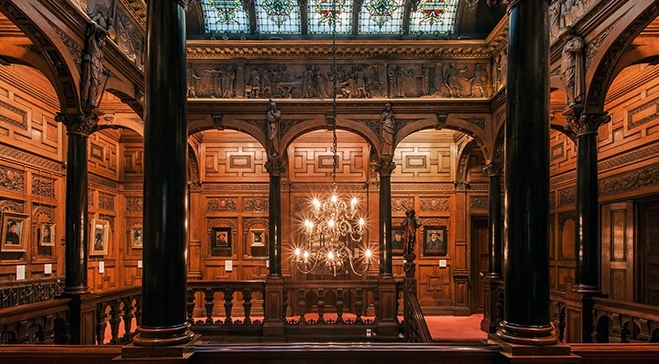The Friends of Dulwich Picture Gallery is arranging a visit to Two Temple Place, an extraordinary building overlooking the Thames from the Embankment.
It had once belonged to William Waldorf Astor, who in his day was considered one of the richest men in the world. His name lives on in the hotel he founded and which still bears his name. He was also a dealmaker of great importance. But did it make him a happy man? When he moved to England in 1891 he had lost his wife and parents and he was feuding with the rest of his family. With his five children he also thought they would be safer in England as he was frightened of the threat of kidnapping. For two years he rented Lansdowne House (now a famous club) and in 1893 he bought Cliveden, now the famous hotel, and two years later he bought 2 Temple Place and set to renovate it and modernise it with the help of the well-known architect John Loughborough Pearson, who pulled in the best craftsmen available to make it an architectural gem.
This house was going to be Astor’s London home as well as his office and he named it Astor House and took a great interest in the details. It is easy to see that no expense was spared. The house is full of quirky details. The staircase is overlooked by a gallery which houses statues with American literary associations, like Pocahontas and Rip Van Winkle. Other figures that inspired Astor and are also depicted like Anne Boleyn - he later bought Hever Castle her childhood home – and Machiavelli and Bismarck, a somewhat odd collection. Even odder is one of the two “ancient” bronzes of naked young boys at the entrance of the house. One boy is seen speaking on a telephone, just Astor’s way of showing how technically advanced he was.
It is said that Astor paid the staggering sum of more than one million pounds to update and decorate the house. He wanted his study to be a showcase for his collection of ancient books and his valuable art works were placed on each floor. After his death in 1919 the house was bought by Sun Life of Canada and renamed Sun Canada House and in 1928 it changed hands again and was sold to the Society of Incorporate Accountants and Auditors for its headquarters.
During the war in 1944 it was badly damaged by a German bomb and part of the building had to be demolished and it took over two years to restore the building to its former glory and it opened its doors again in 1951.
Today the building is managed by The Buildings Trust, a charitable organisation set up in 1983. The house is now open to visitors and also for corporate events. The owners might have been many since Astor’s days but his imprint is still clear to see. Magnificent wood panelling, specially commissioned stain glass windows and floors laid with different sorts of marble. Yet, he was to spend much more of his time and money restoring Hever Castle, which he bought in 1908.
Astor became ennobled first as a Baron in 1916 and a year late he was made Viscount Astor for his generous contributions to different war charities, but it did not make him a popular man. The general public accused him of buying his titles. He died of a heart attack in 1919, not in one of his fabulous homes but in the lavatory in a friend’s house.
This will be a visit not to miss and tickets fly through the door, so book early.
Two Temple Place
Visit organised by Friends of Dulwich Picture Gallery
Monday 10 October 11.00 -12.30
£12, Friends £10
Meet at 2 Temple Place, London WC2R 3BD at 10.45!
Nearest Tube is Temple and it is a 4.5 minute walk to the house
Book online at www.dulwichpicturegallery.org.uk
Or by phone 020 8299 8750 Mon-Friday 10.00am-4.00pm (£2 handling fee)
Or from the Gallery Ticket desk




